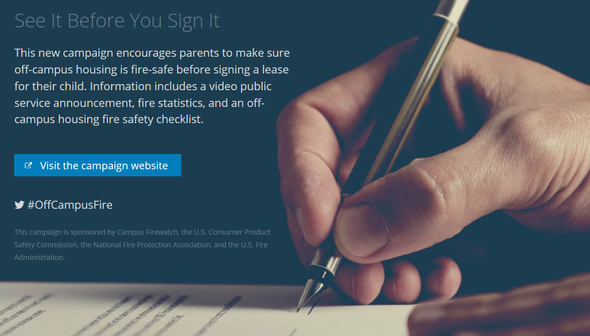|
As college students head
back to school, take a moment to talk with them about fire safety. Each year,
on-and off-campus college and university students are impacted by hundreds of
fire emergencies. Most of these fires are caused by flammable materials and
cooking. The United States Fire Administration (USFA) suggests the following
campus fire safety tips as young adults head off to school:
When cooking:
• Cook only in spaces
where it is permitted.
• Keep cooking area clean
and uncluttered.
• Keep an eye on what's
being cooked, especially if cooking at high temperatures.
• If a fire starts in a
microwave, keep the door closed and unplug the unit.
If smoking:
• Make sure cigarettes and
ashes are out. Never toss hot cigarette butts or ashes in the trash can.
• After a party, check for
cigarette butts, especially under cushions because chairs and sofas catch on
fire fast and burn quickly.
• Be aware of how risky it
is to smoke when drinking or drowsy.
Never
disable or remove batteries from smoke alarms. Smoke
alarms could provide the crucial extra minutes necessary to escape from a fire.
Have a plan, and practice it, that includes multiple escape routes for the same
location.
Join USFA’s campaign, “See
It Before You Sign It” encouraging parents to ensure that off-campus housing is
fire-safe before signing a lease for their child. Visit the campaign website for more
information.
Visit the USFA website at www.usfa.fema.gov for more information on fire safe
college housing.

Each year, September is
recognized as National
Preparedness Month, serving as a call to action to prepare, now and throughout the
year, for the types of emergencies that could affect us where we live, work,
and visit.
This year’s National
Preparedness Month theme is “Don’t Wait. Communicate. Make Your Emergency Plan
Today.” Don’t wait! Make a
plan with your family and friends for how you will stay safe and communicate
during an emergency or disaster that can affect your community. Download the Family
Communication Plan for Parents and Kids, and fill
out the sections before printing or emailing it to your family and friends.
The themes for the four
weeks in September raise awareness about emergency
preparedness including emergency communication plan, community
involvement, and individual preparedness. The last week leads up to
National PrepareAthon! Day on September 30, when the nation will come together
to take action and practice their preparedness in advance of an emergency.
Download the digital
toolkit and become involved with promoting National Preparedness Month by
visiting www.ready.gov/september. More
information about National Preparedness Month will be included in September
editions of the FEMA Bulletin.
One of the 196 manufactured homes that were provided to the Pine Ridge Indian Reservation through the Permanent Housing Construction program.
August 7, 016, marked one
year since President Obama’s disaster declaration for the Pine Ridge Indian
Reservation, kicking off the largest housing effort in the Oglala Sioux Tribe’s
history. To support this effort, FEMA continues to have staff deployed to
the reservation and office space at Ellsworth Air Force Base.
FEMA initiated a permanent
housing construction program for the first time in the continental United
States to address the severe housing needs on the reservation following the May
2015 disaster. In addition to the housing construction program, FEMA provided
more than $435,000 in direct financial aid to tribal members. Of that,
more than $217,000 was for home repairs and $219,000 was for personal property
losses and other emergency needs as a result of the 2015 storm. In
addition, the U.S. Small Business Administration (SBA) approved $943,000 in
low-interest loans to 58 tribal residents and businesses.
To read more on this effort,
click here.
FEMA’s Emergency
Management Institute Higher Education Program invites all employees to a
participate in a webinar on September
28, 2016 from 3:00 p.m. to 4:00 p.m. EDT highlighting
efforts to address research issues in emergency management higher education
programs. The webinar will examine the results of a recent research study by
Arkansas State University students, who will discuss the relationship between
the results of their research, and the perceptions and experiences at their
institutions.
The webinar called "The
Role of Research in Emergency Management Education: Current Status and Future
Directions," features presenters from higher education institutions:
• Deborah J. Persell, PhD,
RN, APN, Director, Regional Center for Disaster Preparedness Education College
of Nursing and Health Professions Arkansas State University
• Jessica Jensen, Ph.D.,
Associate Professor, Department of Emergency Management Co-Director, Center for
Emergency Management Education and Research, North Dakota State University
Interested individuals
should register using the event
registration link and contact Wendy Walsh at wendy.walsh@fema.dhs.gov for
more information on the webinar.
Graduates of the Master in Exercise Practitioner Program Series #37 from the National Emergency Training Center campus.
FEMA congratulates 33
participants in the Master Exercise Practitioner Program (MEPP) Series #37 that
graduated on June 20, 2016, from the National Emergency Training Center campus
in Emmitsburg, Maryland.
MEPP is a series of three
courses focusing on advanced exercise design, conduct, and evaluation practices
in each phase of the Homeland Security Exercise and Evaluation Program (HSEEP).
Candidates apply best practices and lessons learned from their organizations
and experiences, as well as key learning concepts from the curriculum to
exercise planning team assignments. The MEPP is designed to challenge
candidates to demonstrate their expertise within all levels of exercise design
through both in-class and take-home proficiency demonstrations.
The program targets
experienced individuals with significant responsibilities for progressive,
all-hazard exercise programs consistent with the principles in the HSEEP.
Ideal candidates will have three to five years of experience designing and
conducting emergency management exercises consistent with the HSEEP
doctrine.
Congratulations graduates!
Interested professionals should visit http://www.training.fema.gov/mepp/ for more
information.

Draft Disaster Resilience
Indicators Concept Released By Mitigation Federal Leadership Group Subcommittee
FEMA, the National Oceanic
and Atmospheric Administration (NOAA), and their federal partners in the
Mitigation Federal Leadership Group (MitFLG) Disaster Resilience Indicators
Subcommittee released the “Draft
Interagency Concept for Community Resilience Indicators and National-Level
Progress Measures."
This concept is the result
of a year-long effort to identify potential indicators of community resilience
capacity building that align with the Mitigation and Recovery Core Capabilities
under the National Preparedness Goal. Learn more details about this joint
FEMA/NOAA initiative here www.fema.gov/community-resilience-indicators.
The document, compiled in
response to broad public interest in identifying key factors of community
resilience nationwide in order to promote better-informed capacity building
strategies, is intended to start a broad conversation among public- and
private-sector stakeholders on how best to define and track improvements in
community resilience capacity across 28 key indicator categories.
Interested stakeholders
seeking to add their input can submit comments and feedback to the Disaster
Resilience Indicators Subcommittee of the MitFLG at FEMA-CommunityResilience@fema.dhs.gov by August
15, 2016.
The MitFLG subcommittee
was led by representatives of FEMA and the National Oceanic and Atmospheric
Administration and includes significant contributions from federal partners
such as the National Institute of Standards and Technology, the U.S. Army Corps
of Engineers, and the U.S. Geological Survey.
FEMA National Training
Program Continuing Grants
FEMA announced funding
opportunities for the Fiscal Year 2016 Continuing Training Grants program. The
Homeland Security National Training Program’s Continuing Training Grants will
provide $11.5 million to qualified applicants to help improve the nation’s
ability to respond to and recover from all-hazard events.
This highly competitive
program attracts applicants from state, local, tribal, and territorial
governments, eligible non-profit organizations, and higher education
institutions. Funding is provided as cooperative agreements, and awarded
directly to the selected applicants.
For more information and
to download the application package, visit www.grants.gov and submit applications no later
than August 22.
EMI Offers Advanced Public Information Officer Training
Through multimedia lectures and individual and group activities, FEMA’s Advanced Public Information Officer (PIO) course provides participants with the knowledge and skills to establish, manage, and work in a joint information center. The training will allow students to develop strategic messaging in support of incident action plans and manage a joint information center, including personnel. The course uses exercises and lectures to achieve its objectives. The Advanced PIO training is part of a series of eight courses designed for PIOs to teach them to communicate effectively and provide accessible information for all affected disaster survivors.
Nine Advanced PIO course trainings are scheduled over the next year on campus at the National Emergency Training Center in Emmitsburg, Md.
The PIO training program is enhanced by its partnerships with states teaching basic courses that prepare new PIOs for handling daily challenges of informing their communities during emergencies.
The Advanced PIO course enhances skills of the participants through interactive lectures from subject matter experts and functional exercises, including strategic communications and incident action planning as it relates to Joint Information Center operations.
The next Advanced PIO course will be held on August 22-26, 2016 in Broward County, Fla. Interested individuals should contact mike_jachles@sheriff.org to register. For information on prerequisites and course schedules go to http://www.training.fema.gov/programs/pio/e388.aspx.
|